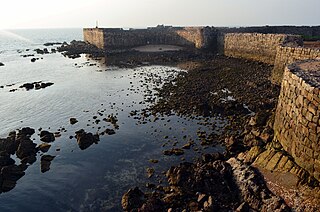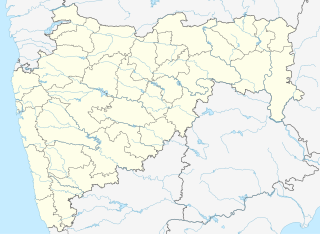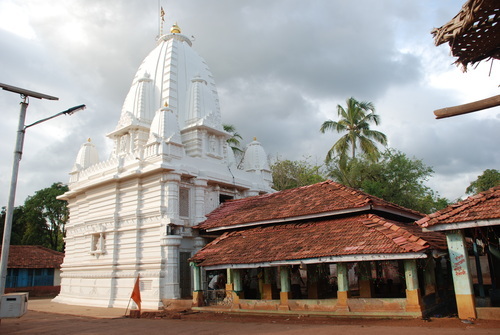
Baji Rao I, born as Visaji, also known as Bajirao Ballal, was the 7th Peshwa of the Maratha Empire. His relationship with his Muslim wife, a subject of controversy, has been adapted in Indian novels and cinema.
Mandhardevi Kalubai temple is near Wai. Located on a hill 4,650 feet above sea level, the temple, some 20 km from Satara, overlooks the picturesque Purandar fort. Devotees attribute miraculous properties to a grove around the shrine. Local lore has it that the temple is more than 400 years old and was built during Chatrapati Shivaji's Maratha rule; no definite date on the construction is available.

Sindhudurg is an administrative district of the Konkan division in India, which was carved out of the erstwhile Ratnagiri district. The district headquarters are located at Oros. The district occupies an area of 5,207 km2 and has a population of 849,651 of which 12.59% were urban. As of 2011 it is the least populous district of Maharashtra.

Kudal is a census town in Sindhudurg district, Maharashtra, India. It is situated on Karli River in southwest Maharashtara. Kudal is the fourth largest town in Sindhudurg after Sawantwadi, Malvan and Kankavli. As of 2011, the population is 16,015. Kudal supports one MIDC area. Kudal railway station is located on the Konkan Railway route and connects the town with Mumbai on the north and Mangalore on the south. It is a major stop for the Konkan Railway with many trains having a halt. The Deccan Odyssey train also stops in Kudal. National Highway 66 passes through Kudal. Apart from that, it also has two bus stations, a new one and old one. The old one is situated in market while the new one is just adjacent to the NH-66. Kudal is situated in centre of the Sindhudurg district and also considered one of the fastest-growing towns in the region.

Nana Phadnavis, born Balaji Janardan Bhanu, was an influential minister and statesman of the Maratha Empire during the Peshwa administration in Pune, India. James Grant Duff states that he was called "the Maratha Machiavelli" by the Europeans.

Nerur is a town of Kudal Taluka of Sindhudurg district of Maharashtra in India. It is one of the smaller towns in the district having 32 wadis. The Malvani dialect of Konkani is spoken here. Nerur is becoming an attraction amongst Indian and foreign tourists from Mumbai and Goa.

Malvanpronunciation (help·info) is a town and taluka in Sindhudurg District, the southernmost district of Maharashtra State, India, well known for the historically important Sindhudurg Fort. Malvan taluka consists of villages such as Angane Wadi Masure, Achra, Khalchi Devli, Jamdul, Juva, Pankhol, Talasheel and Sarjekot. The main occupation here is fishing and agriculture. The staple diet of the local people is fish curry and rice. The town produces Alphonso mangoes and is also known for sweets such as Malvani Khaja made from gram-besan flour and coated jaggery as well as Malvani Ladoos. Other sweets that attract tourists are Konkani meva, Aambawadi, Fanaspoli, dry fruits, Kajuwadi, Naralachya Wadya, and Malvani Masale.

Arnala Fort is built on a small island off the port town of Arnala, located around 13 km north of Bassein, Maharashtra, India. Being an island fort, it is also called Jaldurg or Janjire-Arnala. The Portuguese, who built the present fort, called the island Ilha das Vacas.

Chimaji Balaji Bhat was born in a bhat Brahmin family in 1707 and died in 1740, commonly referred to as Appa or Bhau, was the son of Balaji Vishwanath Bhat and the younger brother of Bajirao Peshwa of Maratha Empire. He was an able military commander who liberated the western coast of India from Portuguese rule. The high watermark of his career was the capture of Vasai fort from the Portuguese in a hard-fought battle. He was known to run strategy for the Maratha Empire and was known to plan all the battles for Bajirao.

Chiplun is a city in Ratnagiri district in the state of Maharashtra, India. It is the financial and commercial Hub of Ratnagiri, and the headquarters of Chiplun taluka. It is about 320 km south of Mumbai in the Konkan region of Maharashtra, on the Mumbai–Goa highway (NH-66). It has a long history and a strong cultural background. Recent decades have seen much industrial development in it and its and surrounding areas.

The Shree Vajreshwari Yogini Devi Mandir is a Hindu temple dedicated to the goddess Vajreshwari, located in the town Vajreshwari, 75 km away from Mumbai. The town, earlier known as Vadvali, was renamed Vajreshwari in honour of the presiding deity of the temple.

Asoli is a small village in Taluka Vengurla and district Sindhudurg of Maharashtra, India.
Menavli is a village about three kilometres from Wai in the Satara district. The village's claim to fame is due to the palace (wada) built by Nana Fadnavis, 18th century Maratha statesman and the regent of Peshwa Madhavrao II.

Jayanti Devi Temple lies at Jayanti Majri village hillock, which is 15 km from Chandigarh in mohali district of Punjab.

Masure is a village located in Malvan taluka of Sindhudurg district, southernmost district of Maharashtra, India, across coastal line. It is around 480 km from Mumbai.

The Chintamani Temple of Theur is a Hindu temple dedicated to Ganesha, the elephant-headed god of wisdom. Located 25 km (16 mi) from Pune, the temple is "one of the larger and more famous" of the Ashtavinayaka, the eight revered shrines of Ganesha in the Indian state of Maharashtra.
Kashibai was the first wife of Bajirao I, the Peshwa to the fourth Maratha Chhatrapati (Emperor) Shahu. With Bajirao, she had four children, including Balaji Baji Rao and Ragunath Rao. Balaji succeeded Bajirao as Peshwa upon the latter's death in 1740. Also following Bajirao's death, Kashibai fostered her step-son, Shamsher Bahadur, whose mother was Bajirao's second wife, Mastani.

Annapurna Devi Mandir, also known as Annapurna Mata Mandir and Annapurna Mandir, is one of the most famous Hindu temples (Mandir) in the holy city of Varanasi. This temple has great religious importance in Hinduism and is dedicated to the goddess Annapurna. Annapurna is the Hindu goddess for nourishment and is a form of the goddess Parvati. The current Annapurna Mandir was constructed in the 18th century by Maratha Peshwa Bajirao I.
The Bhat Peshwa family earlier known as Bhat family is a prominent Indian Chitpavan Brahmin family who dominated India for around 100 years in the 18th century. Most of the members in this family were the Peshwas in the Peshwa Era of the Maratha Empire, and Peshwa later became their family name. During their regime, most of the Indian subcontinent was under their control. The last Peshwa, Baji Rao II, was defeated by the British East India Company in the Third Anglo-Maratha War in 1818. The territory was annexed to the British East India Company's Bombay Presidency, and he was pensioned

Aryadurga devi, Devihasol आर्यादुर्गा देवी देवीहसोळ, is a Hindu temple situated in Devihasol village in Rajapur taluka, Maharashtra, India. It is 18 km (11 mi) from Rajapur, 52 km (32 mi) from Ratnagiri and 380 km (240 mi) from Mumbai. Many devotees come to visit this temple. The fair of Aryadurga devi and Navadurga devi (bhalavli) is also famous, occurring annually in October on the eighth day of the Hindu Navratri festival. Goddess Aryadurga is the Kuldevi of many Karahde Brahmin. Several other temples, including in the towns of Mahakali, Adivare, Marleshwar, and Ganpatipule are located nearby.














